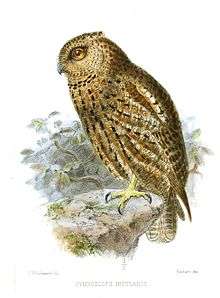Seychelles scops owl
| Seychelles scops owl | |
|---|---|
 | |
| Scientific classification | |
| Kingdom: | Animalia |
| Phylum: | Chordata |
| Class: | Aves |
| Order: | Strigiformes |
| Family: | Strigidae |
| Genus: | Otus |
| Species: | O. insularis |
| Binomial name | |
| Otus insularis (Tristram, 1880) | |
The Seychelles scops owl (Otus insularis), also known as bare-legged scops owl or syer (in Creole) is a rare scops owl species, which only occurs in the Morne Seychellois National Park on the Seychelles island of Mahé.
Description
It reaches a length between 19 and 22 cm. The wings are about 17 cm. Its plumage is rufous brown and exhibits black shaft streaks. The underparts and the facial disc are rufous. The long grey legs are unfeathered. The eyes are large and golden yellow. The ear tufts are very small. Its call which sounds like a rasping "whaugh" with various "tok tok" notes can be heard from a far distance and in particular in the darkness. Its diet consists of geckos, tree frogs and insects (e.g. locusts).
Status
The former range of this bird which was first described in 1880 were the Seychelles islands of Praslin, Mahé, and Silhouette Island. Due to the clearing of the mountainous cloud forests and introduced alien animals, like rats, cats, and barn owls the population had dropped so drastically that it was thought to be extinct by 1906. In 1959 it was rediscovered by French naturalist Phillippe Loustau-Lalanne in a mountainous cloud forest in 200 m asl on Mahé. In 1999 the first nest was discovered but there was no breeding success. In 2000 the first infrared photograph was shot from a female with her juvenile. Due to the lack of information about the population this species was long regarded as critically endangered by the IUCN. Due to the discovery of further populations it was noticed by 2002 that the population was stable at about 318 individuals. Today the range consists of 159 territories which cover an area of 33 km². Thanks to the new knowledge and the conservation efforts on Mahé this species was downlisted to endangered in 2004.
References
- ↑ BirdLife International (2012). "Otus insularis". IUCN Red List of Threatened Species. Version 2013.2. International Union for Conservation of Nature. Retrieved 26 November 2013.
External links
- BirdLife Species Factsheet.
- Sexual size dimorphism in the critically endangered Seychelles Scops Owl Otus insularis
- SPECIES CONSERVATION ASSESSMENT & ACTION PLAN
- ARKive - Photos and Information about the Seychelles Scops Owl
